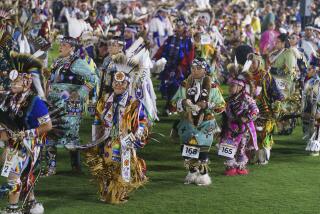Fading Indian Languages Carry a Powerful Message
To many Native Americans, language is a gift from God. They believe it is bestowed on the people by their Maker, like the ability to breathe or to think. To them, so sacred is the genesis of speech that they include it in their creation stories.
Language is what makes people who they are, says Ofelia Zepeda, professor of linguistics at the University of Arizona, and a member of the Tohono O’odham, or desert people, a Southwestern tribe formerly known as the Papago.
But just as language is born, so can it die. That’s what is so sad about the once-thriving languages of Native American peoples, says Zepeda, an expert on endangered Indian languages. From Alaska to the Mexican border, from Hawaii to the Canadian frontier, Indian tongues are facing imminent extinction.
In some smaller tribes, only a handful of elders can still communicate in the language of their ancestors. When their generation dies, their language, their worldview and their way of life will also disappear. One expert predicts that more than 175 distinct tongues will become extinct by 2060.
Recently, language loss has been more gradual and tribes were unsure how to stop it. “We knew it was happening, but to tell the world was another thing,” says Zepeda, 46. “It’s a sad thing to tell them now.”
I met Zepeda last week in San Francisco at the 25th annual conference of the California Assn. for Bilingual Education. In a gentle, almost melancholy tone, she talked about belated efforts to revive moribund Indian languages.
I had been invited to address the conference the night before, following presentations to six schools whose bilingual programs earned the association’s Seal of Excellence. Washington Elementary in Santa Ana was the only Southern California school among those honored.
I thought bilingual educators themselves would be an endangered species by now, but I was wrong.
The conference drew more than 7,000 teachers, principals and parents who rallied around a theme that seems quixotic in our state today: “Bi-literacy for all.” After a demoralizing blow from political efforts to destroy bilingual education, true believers have started to recoup their confidence.
I couldn’t help but compare the drive to defend bilingual programs with the lonely work of Zepeda and others to rescue dying languages. Both causes require hard, uphill battles. Ironically, it was the birth of bilingual education a generation ago that sparked many Indians to focus on saving their own native tongues.
Now it’s the story of Native American languages that gives us a powerful reminder of what’s at stake in the debate over bilingual education.
In a previous column, I suggested that this country’s historic hostility toward any language other than English is oppressive and colonial. Some readers--and a talk show host or two--ridiculed my analysis. But at the time, even I was unaware of the intensity of the U.S. campaign to obliterate Indian tongues, a linguistic war documented by The Times as part of a series in January on how language shapes our hearts and minds.
In 1868, for example, a federal commission on Indian affairs concluded that much of the nation’s troubles could be traced to the proliferation of native languages: “Their barbarous dialect should be blotted out and the English language substituted.”
Sound familiar? The American war against Indian languages left a shameful intellectual legacy, for which the government has barely begun to make amends. In 1990, Congress passed the Native American Languages Act, promising to protect the nation’s unique languages and cultures. As a matter of policy, the law encourages the use of Indian languages in public schools as a way to enhance student performance. But wait a minute, Washington! I don’t think that’s legal here in California.
To be fair, global commerce and communications are threatening languages all across the globe in an era when English has become the language of success. You can’t fight the future.
But somehow, Zepeda still has hope. Many tribes are working to rekindle their languages. Native Americans in California are among the most active. But throughout the country, language preservers are videotaping their grandparents to record their words. They’re also writing new dictionaries, and going to special language camps where the trees and streams and other natural landmarks are labeled with their Indian names.
“We should have English, but not at the expense of other languages,” says Zavala. “We can have them both. It’s not a problem at all.”
Agustin Gurza’s column appears Tuesday. Readers can reach Gurza at (714) 966-7712 or [email protected].
More to Read
Sign up for Essential California
The most important California stories and recommendations in your inbox every morning.
You may occasionally receive promotional content from the Los Angeles Times.










